SpaceX successfully landed another of its Falcon 9 rockets onto a floating drone ship in the early hours of this morning (14th August) after delivering a payload into geostationary transfer orbit (GTO). This makes it the fourth triumphant time that SpaceX has landed the first stage of its rocket onto a football field-sized, unpiloted deck floating offshore - in this case 400 miles into the Atlantic Ocean onto the “Of Course I Still Love You” drone ship.
The payload was JCSAT-16, a commercial communications satellite for SKY Perfect JSAT Corporation launched from Cape Canaveral Air Force Station, Florida at 1:26 am ET, (5:26am UTC) and the return of the first stage to its landing site was already forewarned by SpaceX to be a challenging mission.
Delivering cargo into a geostationary transfer orbit uses up a lot of fuel during take off and it also requires a lot of speed. The first stage, which incorporates nine Merlin engines and aluminum-lithium alloy tanks containing liquid oxygen and rocket fuel, would be subject to extreme velocities and re-entry heating, making a successful landing tricky to say the least.
Despite the complexity of the landing, it all went according to plan and of the 11 rocket landing attempts by SpaceX over the past couple of years, six Falcon 9 vehicles have made it back in one piece. The odds are now, in SpaceX’s favour.
Nonetheless, the mantra of SpaceX, to develop reusable rockets is falling short on its promise, as it has yet to re-use any of its rockets. This key goal is still in sight however as Elon Musk tweeted in June of this year, that they hope for a first re-flight of the fourth rocket that landed in April sometime this September/October.
It is a busy time for SpaceX as it is also hoping for lift off of Falcon Heavy later this year. Falcon Heavy is designed to lift into orbit the mass equivalent of a 737 jetliner loaded with passengers, crew, luggage and fuel (over 54 metric tons), making it the most powerful operational rocket in the world by a factor of two. SpaceX state that the rocket will lift more than twice the payload of the next closest operational vehicle, the Delta IV Heavy, at one-third the cost. It has been purposefully designed with the intention of carrying humans into space, thus keeping alive the dream of sending a crew on a mission to Mars.











